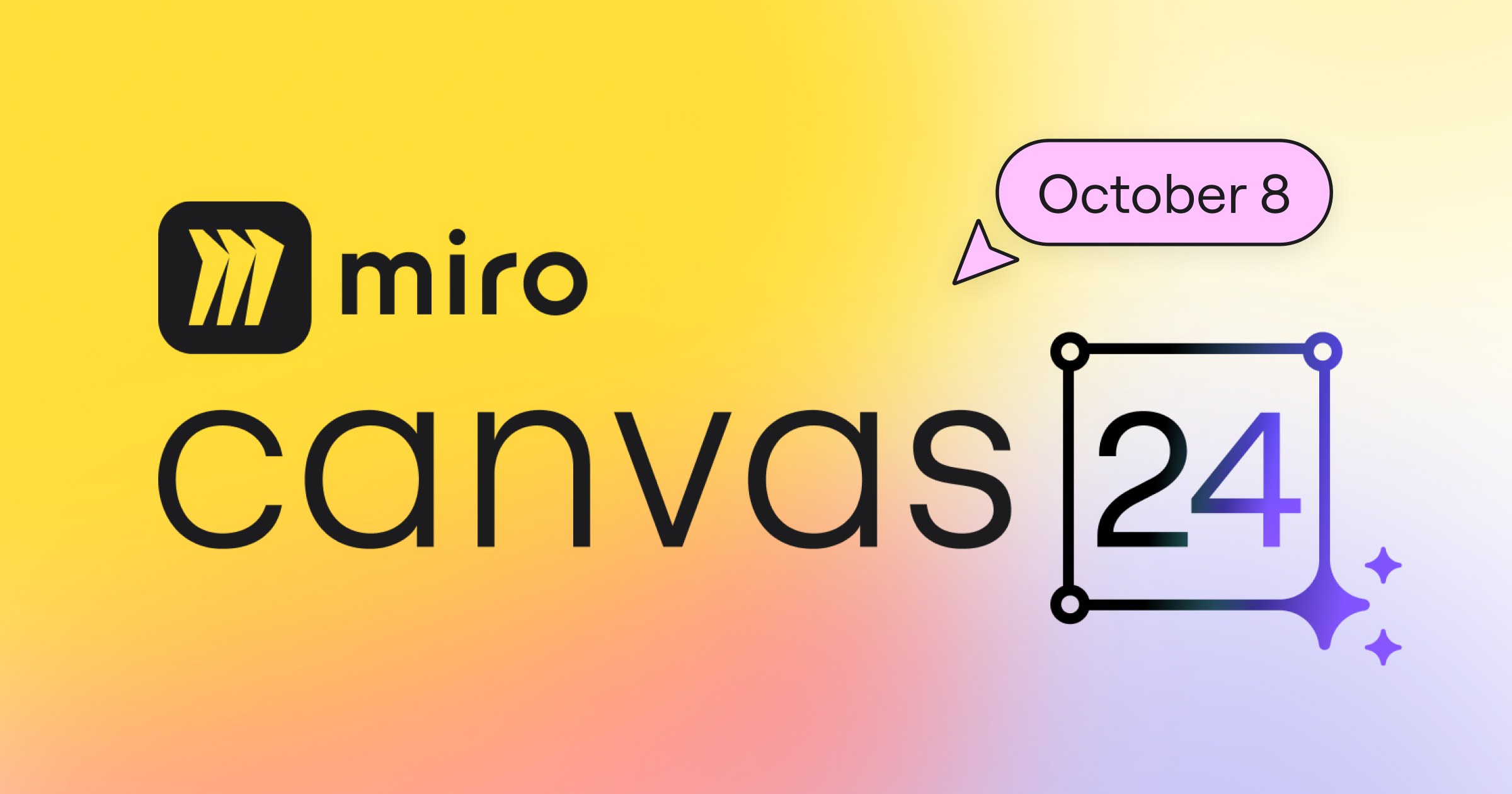At Miro, we’re on a mission to empower teams to build the next big thing — so, innovation is at the heart of everything we do.
That’s why we were thrilled to introduce our new Innovation Workspace, an AI-powered platform designed to help teams get from idea to outcome faster, at our recent Canvas ’24 event in New York City and streaming around the world. In addition to unveiling our biggest product announcement in over a decade, Canvas was an incredible opportunity to bring together industry experts, community creators, and Miro leaders to share new insights on all things innovation.
Here are our top five learnings from all of the thought-provoking conversations at Canvas!
1. Assess your innovation readiness to compete in a rapidly changing world
In an era of rapid change, the ability to innovate quickly separates the best companies from the rest, which is why businesses across the board are prioritizing innovation today. In fact, in the recent “Innovation Systems Need a Reboot” report from Boston Consulting Group, a record 83% respondents say that their companies rank innovation among their top three areas of focus.
And yet, the BCG points out that the majority of these companies lack the readiness to innovate effectively. Miro’s own research reveals that technological challenges are organizations’ top obstacle to achieving their innovation potential. Leaders and information workers alike cite the limits of legacy technology and fragmented tech stacks, which fail to adequately support modern-day, often hybrid, collaboration.
To overcome these obstacles and combat “come here” culture, enterprises are turning to integrated platforms that facilitate seamless collaboration in a centralized space — like our new Innovation Workspace.

2. Harness AI as a catalyst for human creativity and collaboration
Unsurprisingly, artificial Intelligence emerged as a powerful force for accelerating innovation throughout the day — but, more specifically, the human side of AI emerged as a core theme.
In her session “Innovate Faster with Miro AI,” Ioana Teleanu, Lead Product Designer at Miro, spoke about how AI is a powerful tool to help guide conversations, especially among teams with different learning styles. AI doesn’t “replace” the human element, it actually becomes an enabler for even stronger — and more human — connection and collaboration.
“AI can…construct a better space in which we can meet as people and collaborate with this very human experience. It can become an enabler for better conversations and better collaboration.”
Ioana Teleanu, Lead Product Designer at Miro
Ioana’s co-presenter and Miro Community member Tirelle Barron further emphasized the importance of human connection in AI development. He highlighted the adaptability of Miro AI and its usefulness in integrating seamlessly into team workflows, as well as its ability to quickly validate and deliver solutions.
3. Embrace AI-powered prototyping to accelerate innovation and improve engagement
Prototyping took center stage at Canvas as a critical tool for rapid iteration and innovation.
In their session, “Accelerate Product Innovation with Prototyping,” John Vetan, Innovation Strategist, Facilitator and Partner at Design Sprint Academy, and Tony Beltramelli, Head of Product, AI at Miro, discussed how prototyping can validate a product’s desirability before significant resources are invested in development, potentially saving time and enabling faster market entry.
AI can make prototyping more accessible to a wider range of team members and, in turn, more efficient. And the democratization of design not only accelerates iteration, but also brings an element of excitement and engagement to team collaboration.
“Prototyping can greatly uplift the design sprint process, but also lead to a better outcome for the team,” explained Tony. As he describes, team members using AI “get hooked into the prototyping — and that’s amazing.”
4. Strike a balance between people and process to achieve true Agility
The first of four core values from the Agile Manifesto is “individuals and interactions over processes and tools.”
But striking the right balance between people and process has become increasingly challenging in today’s highly automated, technology-enabled world. Indeed, in a recent Miro survey, more than two-thirds of Agile practitioners revealed that processes and tools overshadow individuals in their organization.
In the Canvas session on “Bringing a Human Touch to Agile in Healthcare & Finance,” Emily Belanger — Vice President, Agile Methodology, Standards, and Tooling — shared how Prudential Financial, Inc. strives to alleviate the tension between teams and tools, instead establishing a supportive dynamic between the two:
“We’ve really brought together our technology teams and our business teams in the Agile community, which, in turn, brings our teams closer to the customer. We also focus on integration — how can we make processes seamless for our associates so that they can work together and have tools that support collaboration and are easy to use?”
Emily Belanger, Vice President, Agile Methodology, Standards, and Tooling at Prudential Financial, Inc.
5. Facilitate a culture of innovation with intentional ways of working
Fostering innovation means embracing tools and methodologies that support collaboration, creativity, and efficiency — but innovation is also a deeply human process. So, Miro’s Ways of Working lead, Dom Katz, spoke of the importance of nurturing processes that facilitate a culture of innovation.
When ways of working are too rigid, innovation can stall. Katz cited findings from a recent Miro survey, showing that innovation velocity is important for 91% of enterprises, but less than one in three agree that their current practices and processes actively encourage a quick pace of product development.
To determine whether an organization’s ways of working help or hinder the challenges experienced by team members, Katz suggests asking four key questions for every project:
- Why are we doing it — and why now?
- What problems are we solving?
- How can we learn faster?
- Who do we need to work with?
He and Jen Clark — Senior Customer Training Specialist at Miro — highlighted some of the rituals we’ve implemented at Miro to help us answer these questions. For example, teams adopted the practice of setting a “date for a date,” establishing target deadlines for the key deliverables in every project. As Clark explains, this helps teams “experience that forward momentum of always looking ahead towards the next milestone.”
Embrace a culture of innovation to build tomorrow, starting now
As we saw firsthand at the event, harnessing the power of cutting-edge technologies and human potential can help propel organizations past their competition and into the future of work.
Canvas ’24 was an incredible moment to reflect on the state of innovation today and how teams can leverage Miro’s Innovation Workspace to build an even brighter tomorrow, together.




